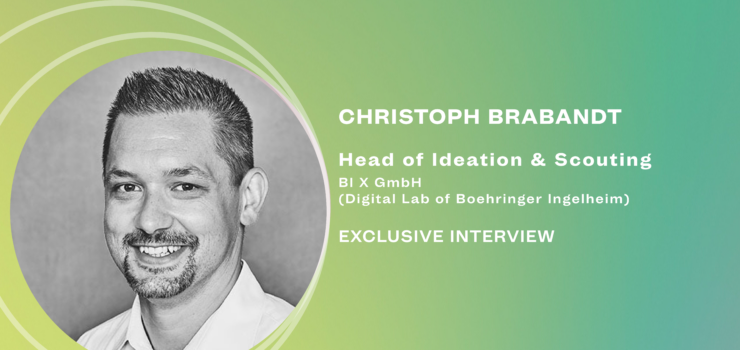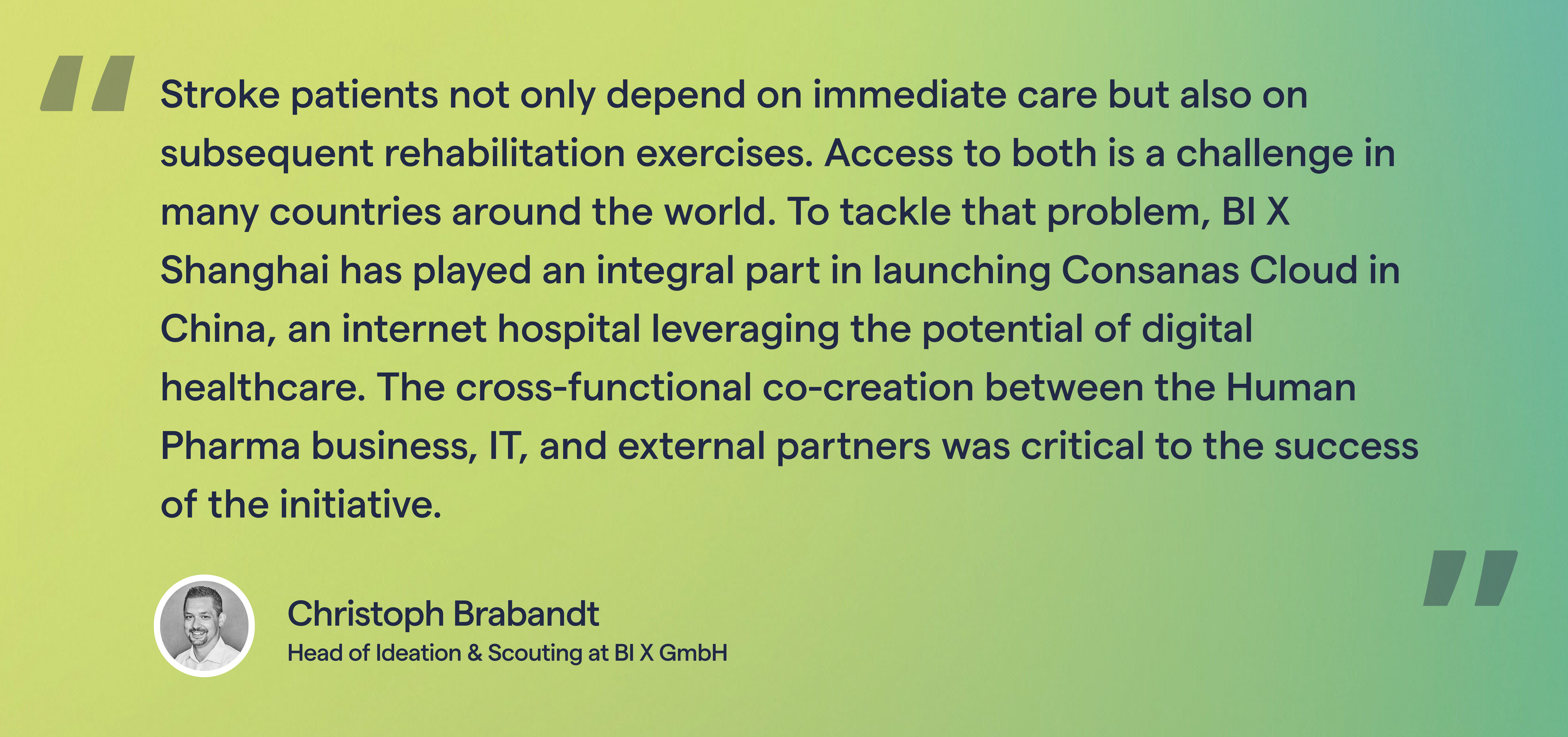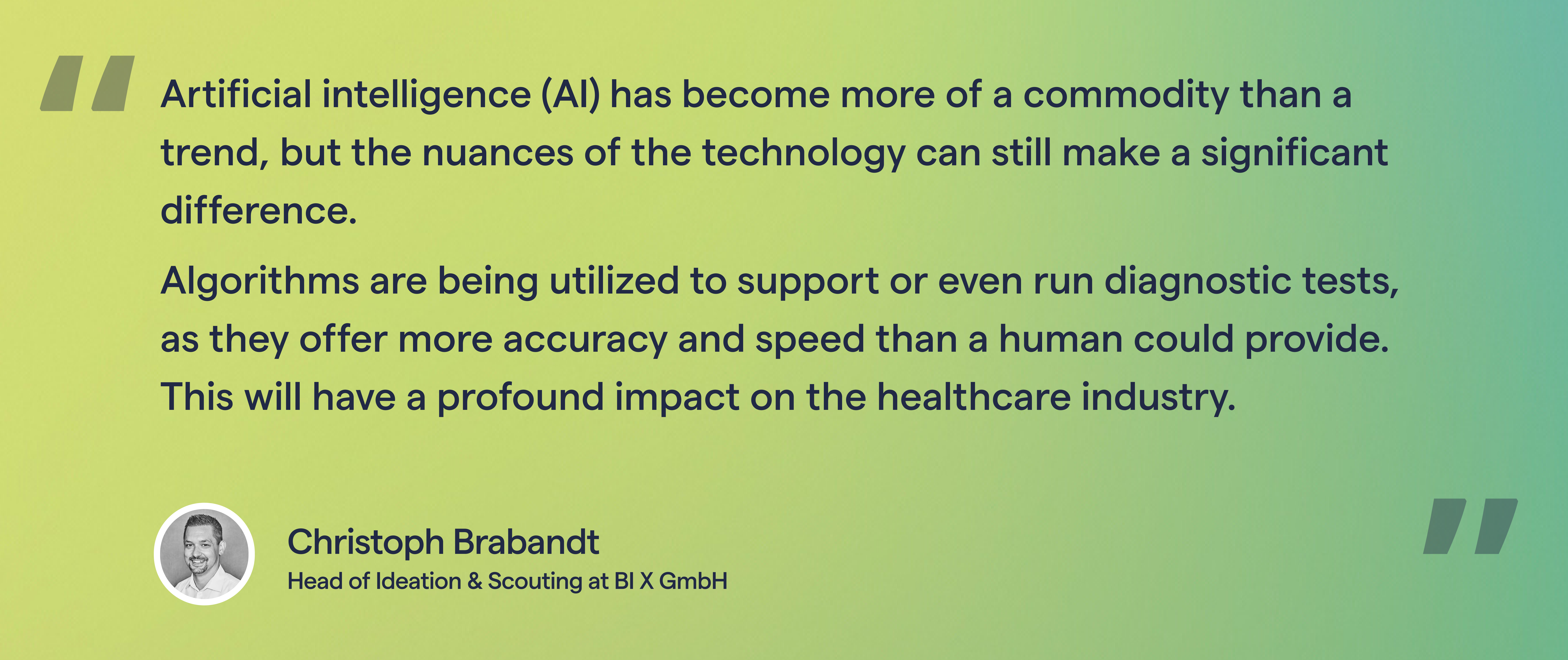Article

From Ideation to Impact: Inside Boehringer Ingelheim’s Healthcare Digital Innovation with Christoph Brabandt, Head of Digital Ideation and Scouting at BI X Digital Lab
Innovation in healthcare has the potential to revolutionize the world by bringing about new discoveries, treatments, and technologies that can enhance the lives of people globally.
Boehringer Ingelheim is a leading research-driven pharmaceutical company with over 130 years of experience, committed to serving humankind by improving human and animal health. As a company whose vision is “Value through Innovation,” they have shown a great deal of innovativeness when it comes to digital technology. Through their Digital Lab BI X, BI is identifying and shaping new digital initiatives for the company through ideation and scouting.
So, how does a family-owned pharmaceutical company remain at the forefront of innovation in a rapidly changing life-science ecosystem?
In this interview, we talk to Christoph Brabandt, the Head of Digital Ideation and Scouting at BI X, which is part of Boehringer Ingelheim. Brabandt discusses his role in identifying and shaping new digital initiatives for the company through ideation and scouting. Additionally, he shares his views on various trends including the shift towards preventive healthcare and the need for companies to adapt to the changing landscape of the industry.
Read the interview to learn more.
1. As a Head of Digital Ideation and Scouting at BI X, your team’s role is to support Boehringer Ingelheim in identifying and shaping new digital initiatives. Could you give us some insight into your responsibilities and approaches?
As given in my title, my role comprises two main aspects: ideation and scouting. Ideation involves connecting with both internal stakeholders and customers to identify unmet needs within our organization and among our customer base, which may include patients, doctors, pet owners, or veterinarians. So, we have a wide range of opportunities that we are looking to explore. To achieve that, we use various methodologies, such as design thinking, to explore these opportunities and develop solutions ourselves or with external partners.
On the other hand, scouting involves open innovation, where we connect with academic networks, start-ups, other companies, and labs to identify trends and opportunities outside of BI.
This holistic approach is necessary because, while internal ideas are valuable, they represent only a small part of the innovation picture. What we aim to encourage is big-picture thinking. My team’s role is to facilitate ideation and scouting, while our lab works on delivering and developing solutions either independently or through partnerships.

2. To ensure that innovative solutions are constantly challenged and remain diverse, you also work with external partners such as start-ups, tech companies and academia. How does Boehringer Ingelheim choose which ideas to work on and which partners to collaborate with?
Well, you never know for certain whether the partner you are choosing to work with is the right one. However, at our company, we understand the importance of this decision and work diligently to select the best possible collaborator for each project.
We start by identifying the priorities in our business strategies and working with key stakeholders in the company to determine the themes we want to explore. From there, we search for relevant partners and stakeholders and invite them to submit proposals. With multiple proposals for each idea, we undergo a classical selection process to determine the best partner for the job. Finally, we move forward with a proof of concept to see whether the solution works. If not, we’re not afraid to pivot and select a different partner. Our dedication to finding the right fit has led to many successful partnerships and innovations.
3. Boehringer Ingelheim has a strong track record of successful digital innovation projects. Can you share with us some examples of digital products that you are particularly proud of and tell us why?
Boehringer Ingelheim has a remarkable history of successful digital innovation projects. While some projects are internal and confidential, there are external projects that can be shared.
One of the most interesting recent developments has been launched in China. In addition to the physical stroke rehabilitation center that Boehringer Ingelheim has built in Shanghai, we have created a virtual stroke rehabilitation program. Stroke patients not only depend on immediate care but also on subsequent rehabilitation exercises. Access to both is a challenge in many countries around the world. To tackle that problem, BI X Shanghai has played an integral part in launching Consanas Cloud in China, an internet hospital leveraging the potential of digital healthcare. The cross-functional co-creation between the Human Pharma business, IT, and external partners was critical to the success of the initiative.
Another example comes from our Animal Health section, where we began exploring different ways of getting in touch with pet owners. We began developing an application that lets US pet owners access pet health care services like teleconsultations with their vet. We were ahead of the game, when the pandemic struck, pet owners couldn’t go to the vet anymore, and this app opened up new possibilities to connect. The platform has been sold to a company that has previously partnered with Boehringer Ingelheim.
There are multiple internal innovation initiatives underway right now, machine learning and artificial intelligence are used to enhance our innovation processes in the research and manufacturing divisions.

4. In a recent webinar I discussed the benefits of composable solutions for pharmaceutical companies looking to respond to the rise of eCommerce. As a healthcare digital innovation leader, what’s your opinion on the impact of headless and cloud-native technologies on healthcare eCommerce? What other trends do you find interesting in the industry’s eCommerce field?
Whether we see the application of cloud-native and MED API-driven technologies at Boehringer Ingelheim – the answer is clearly yes. However, this is a short answer to a broad question.
In terms of trends, I find the shift toward preventive healthcare—as opposed to just treating patients—to be very interesting. This paradigm shift forces us to reconsider how we conduct business in the sector because it may result in the sale of less medication. Finding innovative methods to innovate and provide value to our patients is essential in this always changing environment.
Furthermore, the traditional way of having sales representatives visit physicians is already changing, as they find it difficult to make time. The relevance of the digital environment has been underlined and this transformation was accelerated by COVID. To better serve our clients, we must take advantage of this trend and adjust to the new environment.

5. Digital innovation in healthcare is rapidly evolving. What current trends excite you the most, and what do you think we can expect to see over the next 5-10 years? Moreover, to what extent are those trends predictable?
Digital innovation in healthcare is continuously evolving, and there are many exciting trends that are emerging. Artificial intelligence (AI) has become more of a commodity than a trend, but the nuances of the technology can still make a significant difference. Algorithms are being utilized to support or even run diagnostic tests, as they offer more accuracy and speed than a human could provide. This will have a profound impact on the healthcare industry.
Another important trend is the movement towards bringing healthcare to people’s homes. Monitoring their health at home can help people in rural areas or those who prefer not to visit doctors regularly. This will lead to a shift in the overall healthcare system, as people will be able to access medication and treatment from their homes.
Virtual rehabilitation is another trend that will help people access treatment from home. These two trends are just the beginning of the exciting possibilities in digital healthcare innovation.
In terms of predictability, the pharmaceutical industry operates differently from other industries due to its longer planning cycles, making it easier to predict. While predicting the upcoming drugs, diseases, and treatments that will be developed in the next five to ten years is possible, what is more difficult to predict is who the actual customers will be or how the market will look. Pharmaceutical companies can only predict the patients who will potentially be treated. The development cycle for new drugs takes about ten years, followed by ten years on the market. Therefore, pharmaceutical companies have to plan for twenty years of patent exclusivity. The companies already know what will be in their pipelines in the next five years and will support their patients over the next 15 years.

6. What advice would you give to other companies that are looking to drive digital transformation and innovation within their own industries, and what are some of the key challenges that they should be aware of?
There is one very simple piece of advice: ‘Start by thinking about the why’ – Simon Sinek.
Why are you doing this? What is the reason for going digital in the first place? You need to establish a goal, a strategy, or an ambition – whatever term you prefer – but you must have a clear objective for your team to work towards. Don’t just do digital for the sake of it ; understand the purpose behind it. This will also help you measure progress and track success. However, it’s important to keep in mind that digital is different from classical IT or other projects. It’s faster, requires iteration, and involves experimenting with different approaches.
Many things may fail before you find what works, so be open-minded and willing to test different ideas until you find the right fit.

About Christoph Brabandt
As the Head of Ideation and Scouting at BI X, Christoph Brabandt is passionate about discovering and developing innovative solutions to healthcare challenges. With his expertise in open innovation and digital strategy, Brabandt brings fresh perspectives and ideas to the table. Alongside his team, he is dedicated to identifying the best opportunities to benefit customers and partners. Their ultimate goal is to ensure that their products solve customers’ problems effectively.
About Author
Elena Dimoska is a communications & marketing enthusiast with great passion to communicate value in a way that reinforces business success beyond revenue growth.
One of her missions as part of TrueNode is to internalize the topic of innovation and digital transformation in large enterprises and to help more well-known brands leverage innovation to make impact. For that purpose, Elena is interviewing innovators from well-established brands across Germany and Europe.






